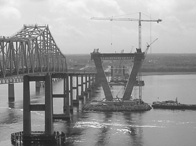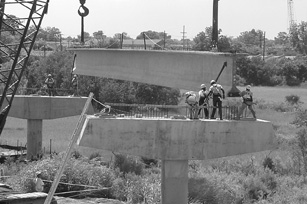U.S. Department of Transportation
Federal Highway Administration
1200 New Jersey Avenue, SE
Washington, DC 20590
202-366-4000
Focus
| Accelerating Infrastructure Innovations |
Publication Number: FHWA-RD-03-021
Date: September 2003
In 1929, the first bridge over the Cooper River and Town Creek in Charleston, South Carolina, opened with a 3-day gala celebration. The 4.36-km (2.71-mi) bridge, later to be known as the Grace Memorial Bridge, was the fifth largest structure of its type in the world at that time. The landmark bridge was followed by construction of a second structure over the Cooper River, the Pearman Bridge, which opened to traffic in 1966. In recent years though, it became clear to the South Carolina Department of Transportation (SCDOT) and the community that the two bridges had become functionally obsolete. The Grace Memorial Bridge has only two 3-m (10-ft) lanes, lacks shoulders, and has only a limited ability to carry vehicles weighing more than 5 tons. The Pearman Bridge, meanwhile, provides two northbound lanes and one southbound lane, but does not have emergency shoulders or a median to separate opposing traffic. And neither bridge has enough vertical or horizontal clearance to safely accommodate today's larger shipping vessels. "The two older bridges were congested and in dire need of replacement," says Charles Dwyer of the SCDOT.
Replacing the two bridges with a new Cooper River Bridge has required the SCDOT and the Federal Highway Administration (FHWA) to identify innovative sources of funding for the massive project and to work closely with residents, city and town officials, and others in the surrounding communities to choose a context-sensitive design that would fit in with the historical aesthetic of the city and to minimize the impact of the construction on the community.
A design/build contract for the new Cooper River Bridge was executed in July 2001 with Palmetto Bridge Constructors (PBC). PBC is a joint venture of Skanska USA and HBG Constructors. The lead designer is Parsons Brinckerhoff. Construction of the bridge is required to be completed by 2006. Construction has been accelerated, however, and the contractor is now aiming to complete work early by having both directions of traffic using the new bridge in the summer of 2005. As of August 2003, more than 50 percent of the bridge's concrete had been placed. The use of the design-build concept has helped accelerate the completion of the largest single infrastructure contract in SCDOT's history.
 |
| This view of the new Cooper River Bridge under construction in Charleston, SC, shows reinforcing steel in the bridge's Eastern Tower. |
The new Cooper River Bridge will have the longest cable-stay span in North America, stretching 471-m (1,546 ft) across the Cooper River. The total length of the bridge is 4.02 km (2.5 mi). A diamond tower design was chosen after several public hearings provided feedback on various design options. "There was a lot of public input as to what the structure would look like. The community involvement has been an ongoing effort," says Tad Kitowicz of FHWA's South Carolina Division Office. "We have held a lot of public hearings and worked hard to involve residents. As Charleston is a historic city, we need something that will fit with the surrounding area and become a landmark of the city," adds Dwyer. A 3.6-m (12-ft) bicycle and pedestrian lane was added to the design at the urging of the local community. The lane includes observation sites with benches. Additional interchange ramps were also added after consultation with local officials. To encourage public input and feedback on the project and provide information, a Community Bridge Office was set up. A Web site (www.cooperriverbridge.org) has also provided frequently updated news and information on the project.
|
| Large concrete girders for the new bridge are set in place |
 |
| The first concrete girder is set into place between two pier caps for the new bridge's Meeting Street off-ramp. |
The new bridge's cable-stayed span will be suspended by 128 cables from two diamond towers at each end of the span. The cables are to be anchored on the bridge's deck level and inside of the diamond towers. To protect them from weather conditions, the bridge cables will be enclosed in a high density polyethylene pipe. The diamond towers will support an eight-lane road deck that is almost 61 m (200 ft) above the median high tide mark. Platforms and tower elevators that can be used for safety inspections and maintenance have been incorporated into the design.
With a project budget of $677 million, SCDOT had to develop an innovative financing plan that includes several partners. The South Carolina Infrastructure Bank, which was established by the State in 1997 to provide loans and other financial assistance for major projects, has contributed $325 million in funding. A $215 million Federal loan was provided under the Transportation Infrastructure Finance and Innovation Act, which is being repaid by SCDOT, Charleston County, and the South Carolina State Ports Authority. Additional funding has come from FHWA.
To learn more about the Cooper River Bridge Project, visit the Cooper River Bridge Web site at www.cooperriverbridge.org or email the SCDOT at info@cooperriverbridge.org.